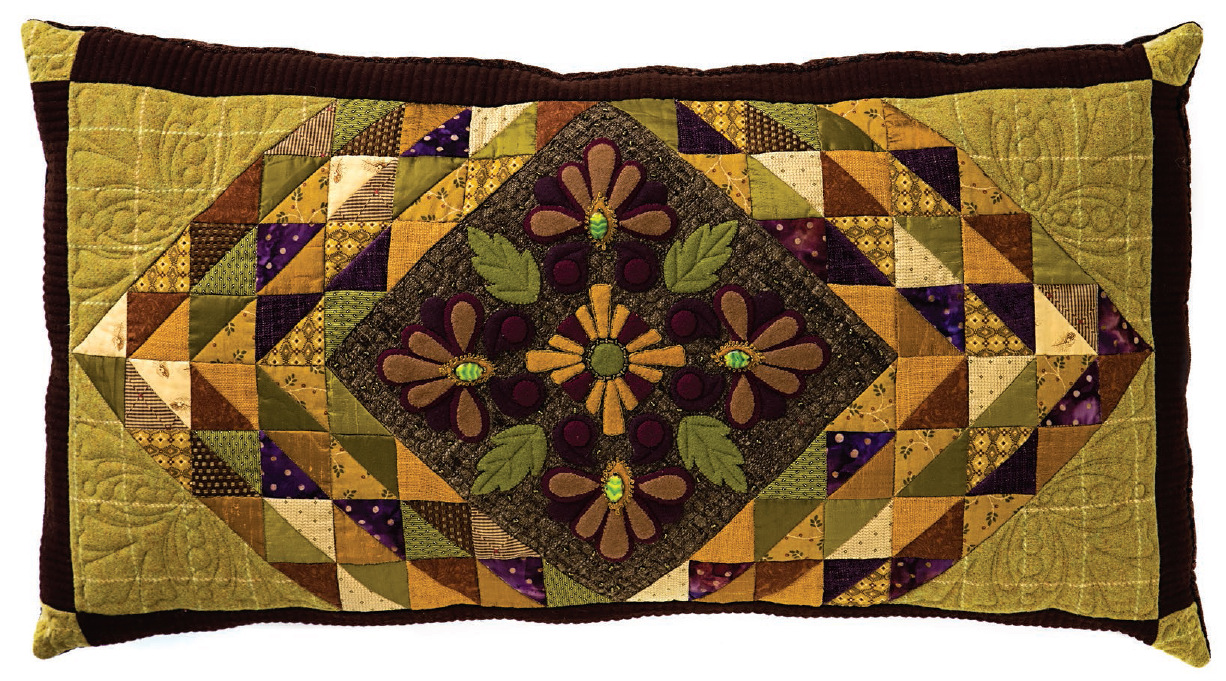
Echoes of Italy Bolster
Finished Birds in the Air blocks: 8˝ × 8˝
Finished bolster: 20˝ × 36˝
The bolster version of Echoes of Italy uses the same Birds in the Air blocks and construction methods as the table runner project. Follow the sewing directions for the runner, but work in the quantities specified below. Note that the yardage needed is not what dictates the mixed-medium fabric requirements. It is the variety. The runner uses eighteen fabrics, but this bolster would have adequate yardage using twelve fabrics. Project fabrics included two silk dupionis, silk matka, Radiance silk/cotton blends, two to five different grades of home decor textiles, a batik, and five to eight traditional cottons. More variation in the fabrics will give you more interest in the finished top. More is better here!
Many eclectic projects lend themselves to embellishment. Sometimes it’s embroidery embellishment; sometimes it’s beading. The bolster version of this project illustrates a bit of both. Of special note is the background treatment. I used a bead referred to as a peanut bead to add a metallic background texture rather than just a graphic outline for the appliqué.
Read Exploring New Textiles: Eclectic Fabric Guidelines before beginning.
Materials
FABRICS FOR BLOCKS AND BORDER
Mixed-medium fabrics: 1¼ yards total of 18 fabrics for half-square triangles
Green plaid wool: ⅓ yard for Birds in the Air blocks and border corners
Bronze textured silk matka: 1 fat quarter (18˝ × 20˝) or ½ yard for appliqué background
Brown chenille upholstery: ¼ yard for border
HAND-DYED WOOL FOR APPLIQUÉ
Garnet, dark plum, and seal brown: 6˝ × 8˝ each for medallion
Gold: 6˝ × 8˝ for medallion and small circle accents
Green: Approximately 8˝ × 22˝ for leaves
OTHER MATERIALS
Interfacing for hand-dyed wools and silks
Muslin (at least 40˝ wide): ⅔ yard
Polyester fiberfill
Color-coordinated wool thread for appliqué
Backing: ¾ yard
Batting: 28˝ × 44˝
Embroidery threads (optional)
Accent beads (optional)

Cutting
MIXED-MEDIUM FABRICS
• From each of the 18 fabrics, cut 3 squares 2⅞˝ × 2⅞˝ for the pieced triangle units. Cut 10 additional squares 2⅞˝ × 2⅞˝.
Choose 16 of the lighter-weight squares and cut in half diagonally.
GREEN PLAID WOOL
• Cut 2 squares 8⅞˝ × 8⅞˝; cut in half diagonally.
• Cut 4 squares 2½˝ × 2½˝.
BRONZE TEXTURED SILK MATKA
• Cut 1 square 14˝ × 14˝.
BROWN CHENILLE UPHOLSTERY
• Cut 2 strips 2½˝ × 32½˝.
• Cut 2 strips 2½˝ × 16½˝.
MUSLIN
• Cut 1 piece 28˝ × width of fabric.
BACKING
• Cut 1 piece 20½˝ × 36½˝.
Construction
All seam allowances are ¼˝ unless otherwise noted. Fabrics are paired right sides together. Prepare all the fabrics before you cut; refer to Exploring New Textiles: Eclectic Fabric Guidelines. Interface all silks and unstable weaves.
HALF-SQUARE TRIANGLE UNITS
Refer to Echoes of Italy Table Runner, Half-Square Triangle Units.
1. Choose 24 pairs of 2 squares each from the 2⅞˝ mixed-medium squares. Draw a diagonal line from corner to corner on the wrong side of the lighter-weight square of each pair.
2. Layer the squares of each pair right sides together and sew ¼˝ on each side of the drawn line.
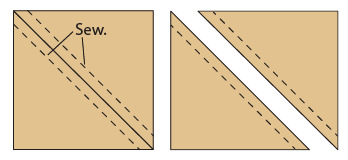
Half-square triangle units
TIP • A walking foot or even-feed foot is helpful for some of the heavier textures but is not mandatory. By pairing a cotton with a specialty fabric and drawing the diagonal line on the cotton, you will be feeding the pair through your machine with the specialty fabric on the bed of the machine. This helps with both nap issues and stretch.
3. Cut on the drawn line and press open. Traditionally, we press away from light-color fabrics. In eclectics, press away from the heavier of the 2 fabrics you have paired. In the case of the home decor textiles, you may have greater success pressing the seams open.
4. The half-square triangle units will measure 2½˝ × 2½˝. Make 48.
BIRDS IN THE AIR BLOCKS
The Birds in the Air blocks are assembled using the mixed-medium half-square triangles and the green plaid wool triangles. The intent is to have these blocks read scrappy. Light and dark color placement does not need to be consistent, but, as always, the decision is yours to make. Half of this block is solid, and half is pieced from the 2½˝ half-square triangle units and the diagonally cut triangles. You will assemble eight large pieced triangles for your project; four will be combined with the green plaid wool triangles to complete the Birds in the Air blocks, and four will surround the appliquéd background.
1. For each pieced triangle, select 6 mixed-medium half-square triangle units and 4 mixed-medium triangles. Arrange the triangle units and triangles in 4 rows following the pieced triangle assembly diagram.
Row 1: 3 half-square triangle units and 1 triangle
Row 2: 2 half-square triangle units and 1 triangle
Row 3: 1 half-square triangle unit and 1 triangle
Row 4: 1 triangle
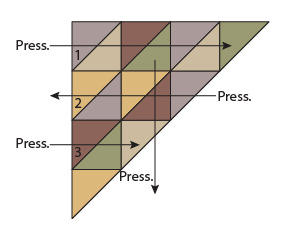
Pieced triangle assembly
2. Using a walking foot or even-feed foot, sew the units together in rows. Press the rows in alternating directions.
3. Sew the rows together as shown, and press the seams toward the block centerline. Once all 8 of the pieced triangles are assembled, set aside 4 for use around the appliqué background, and finish the assembly of the Birds in the Air blocks.
4. Sew together 1 green plaid wool triangle and 1 large pieced triangle. Place the pieced triangle on top of the wool as you feed it through your machine. The wool will be on the bed of the machine. This will allow you to see and control the joins on the pieced section as you sew and help in minimizing the stretch of the wool.
5. The block will measure 8½˝ × 8½˝. Make 4.

Birds in the Air block
Appliqué
Refer to Wool Appliqué … My Way.
1. Prepare the appliqué pieces in the quantities indicated using the project patterns.
TIP • For the circles, I sometimes draw directly onto the freezer paper with an architectural circle template, a tool left over in my crayon box from my first design life! You may prefer to do the same.
Note: The textured silk matka used for the appliqué background has a looser weave than many silks. It would benefit from being stabilized with a lightweight interfacing like Touch O’Gold II. I chose the black version of this interfacing so that the color would not be seen on the face of the finished project.
2. Refer to Echoes of Italy Table Runner, Appliqué to appliqué, re-center, and trim the background silk matka square.
3. If desired, embellish your project with embroidery before it is sewn together with the pieced blocks. The embroidery threads I used are all from Wonderfil. Refer to Embroidery.
Assembly
1. Add the 4 remaining pieced triangles to the appliquéd medallion background. Refer to the appliqué block assembly diagram. The background is now on point. Depending on the weight of the fabrics in the seam, press the seams open or toward the center on 2 parallel sides and away from the center on the 2 remaining sides. The completed appliqué block will now measure 16½˝ × 16½˝.
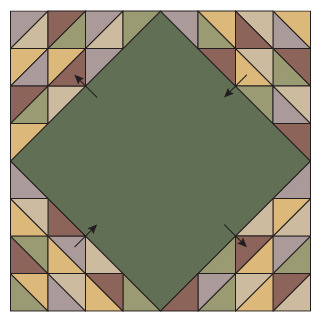
Appliqué block assembly

Appliqué
TIP • Add beads after the top has been quilted but before it is assembled into the bolster. It is much easier to quilt the top freely without the beads in place, and this also eliminates the chance that the beading threads will be caught by the machine and broken.
2. Join the 4 Birds in the Air blocks into 2 columns of 2 blocks each. Rotate the blocks so that they are oriented as shown in the bolster assembly diagram.
Note: The medallion appliqué block is centered in this project.
3. Sew the columns together as shown. Press the joining seams open.
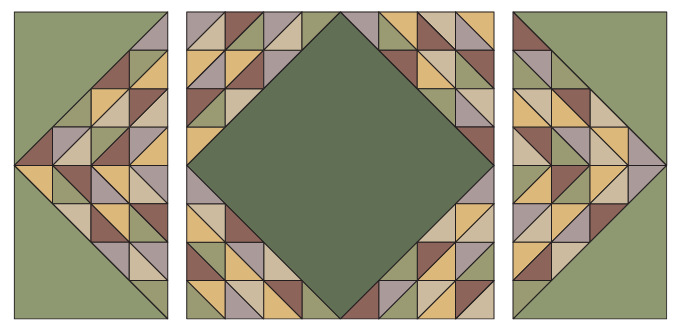
Bolster assembly
4. Sew the 2 brown chenille upholstery 32½˝ strips to the top and bottom of the project. Press the seams open.
5. Sew the 2½˝ green plaid wool squares to each end of the 16½˝ brown chenille upholstery strips. Add the pieced side borders to the project. Press the seams open. The top will measure 20½˝ × 36½˝.
Finishing
1. Sandwich the batting between the bolster top and muslin. Quilt as desired. Trim to 20½˝ × 36½˝.
2. Add beading to your project, if desired (see Beading).
3. Layer the finished top and the 20½˝ × 36½˝ backing piece, right sides together. Stitch around the entire perimeter of the piece with a ¼˝ seam allowance, leaving an opening large enough to turn the bolster right side out. Clip the corners and turn.
4. Stuff lightly with polyester fiberfill and hand stitch the opening closed.
TIP • Do not overstuff. This may cause the pillow to be overly round and lofty, thereby making the appliqué less visible when displayed.